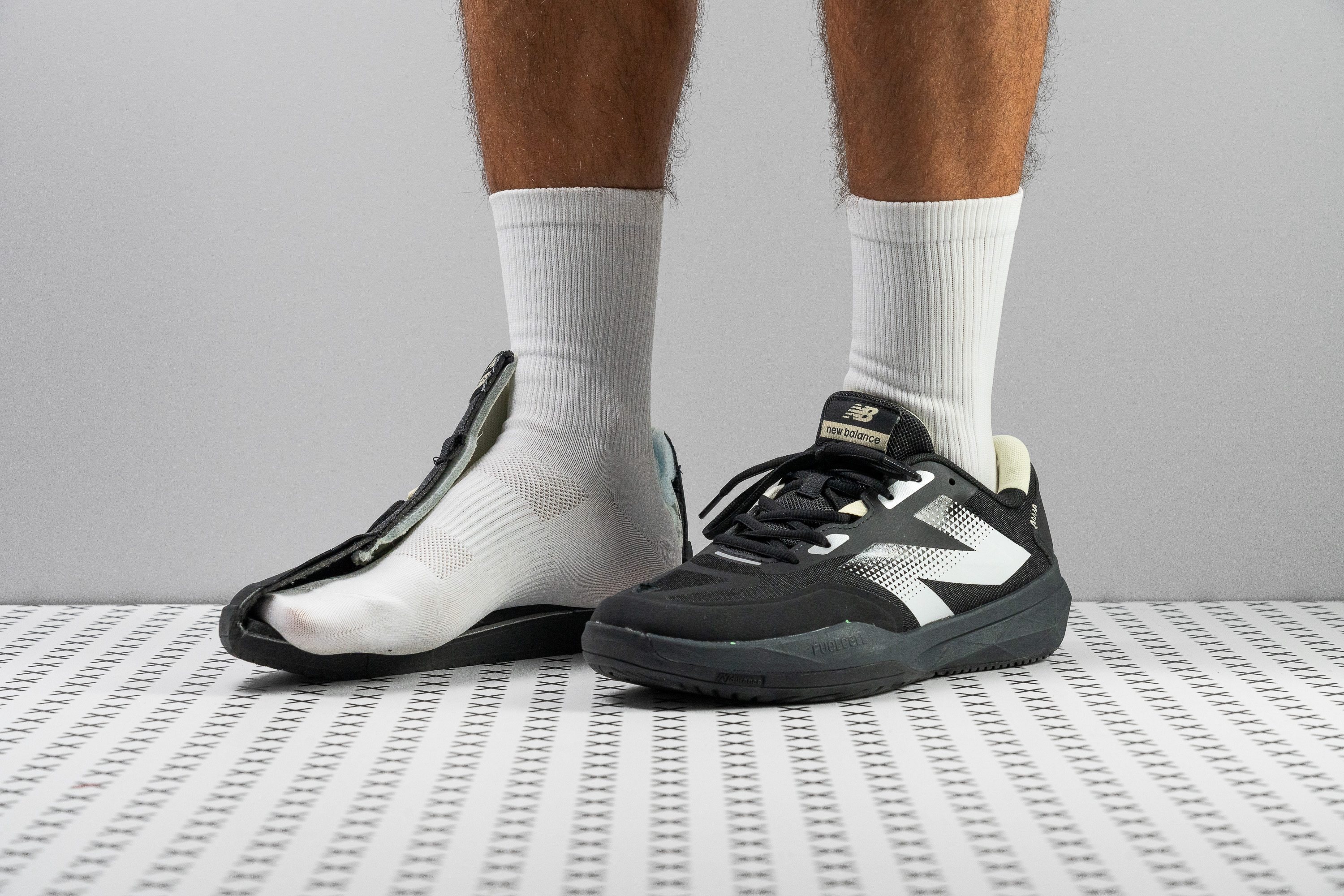Our verdict
Pros
- Fair value for money
- Comfortable step-in feel
- Good impact protection
- Sufficient stability
- Sturdy toe drag guard
- Reliable grip
Cons
- Not breathable at all
- Not very durable
Audience verdict
Comparison
The most similar tennis shoes compared
+ + Add a shoe | |||||
|---|---|---|---|---|---|
| Audience score | 67 Bad! | 86 Great! | 89 Great! | 88 Great! | |
| Price | $90 | $135 | $120 | $110 | |
| Shoe type | All Court | All CourtHard Court | All CourtHard Court | All Court | |
| Shock absorption | - | - | Moderate | Moderate | |
| Energy return | - | - | Moderate | Moderate | |
| Traction | - | - | Moderate | Moderate | |
| Construction | Stability | Stability | Stability | Speed | |
| Breathability | Warm | Warm | Moderate | Moderate | |
| Weight lab | 12.2 oz / 346g | 12.9 oz / 367g | 14 oz / 397g | 12.3 oz / 349g | |
| Lightweight | ✓ | ✗ | ✗ | ✓ | |
| Drop lab | 7.5 mm | 9.1 mm | 6.3 mm | 9.8 mm | |
| Width / fit | Medium | Medium | Medium | Wide | |
| Toebox width | Medium | Medium | Narrow | Medium | |
| Size | Half size small | True to size | Slightly small | True to size | |
| Midsole softness | Balanced | Balanced | Firm | Balanced | |
| Stiffness | Stiff | Stiff | Stiff | Stiff | |
| Torsional rigidity | Moderate | Moderate | Moderate | Moderate | |
| Heel counter stiffness | Stiff | Stiff | Moderate | Flexible | |
| Midsole width - forefoot | Wide | Average | Wide | Very wide | |
| Midsole width - heel | Average | Average | Wide | Average | |
| Outsole durability | Bad | Decent | Good | Decent | |
| Heel padding durability | Bad | Bad | Decent | Decent | |
| Heel stack lab | 28.4 mm | 29.1 mm | 29.7 mm | 29.2 mm | |
| Forefoot | 20.9 mm | 20.0 mm | 23.4 mm | 19.4 mm | |
| Insole thickness | Average | Thin | Average | Very thick | |
| Removable insole | ✓ | ✓ | ✓ | ✓ | |
| Heel tab | None | None | None | None | |
| Toebox durability | Decent | Good | Decent | Good | |
| Outsole hardness | Average | Average | Average | Very hard | |
| Outsole thickness | Very thick | Average | Thin | Average | |
| Ranking | #38 Bottom 2% | #18 Top 47% | #7 Top 18% | #12 Top 31% | |
| Popularity | #37 Bottom 5% | #38 Bottom 2% | #11 Top 29% | #9 Top 24% |
Who should buy
In our opinion, the New Balance 796 v4 is worth considering if:
- you are just starting out with racquet sports and don't want to invest a lot of money
- you want a basic tennis shoe with decent performance on all fronts
- you have medium-to-wide feet and need an accommodating toebox
- you play in cooler weather
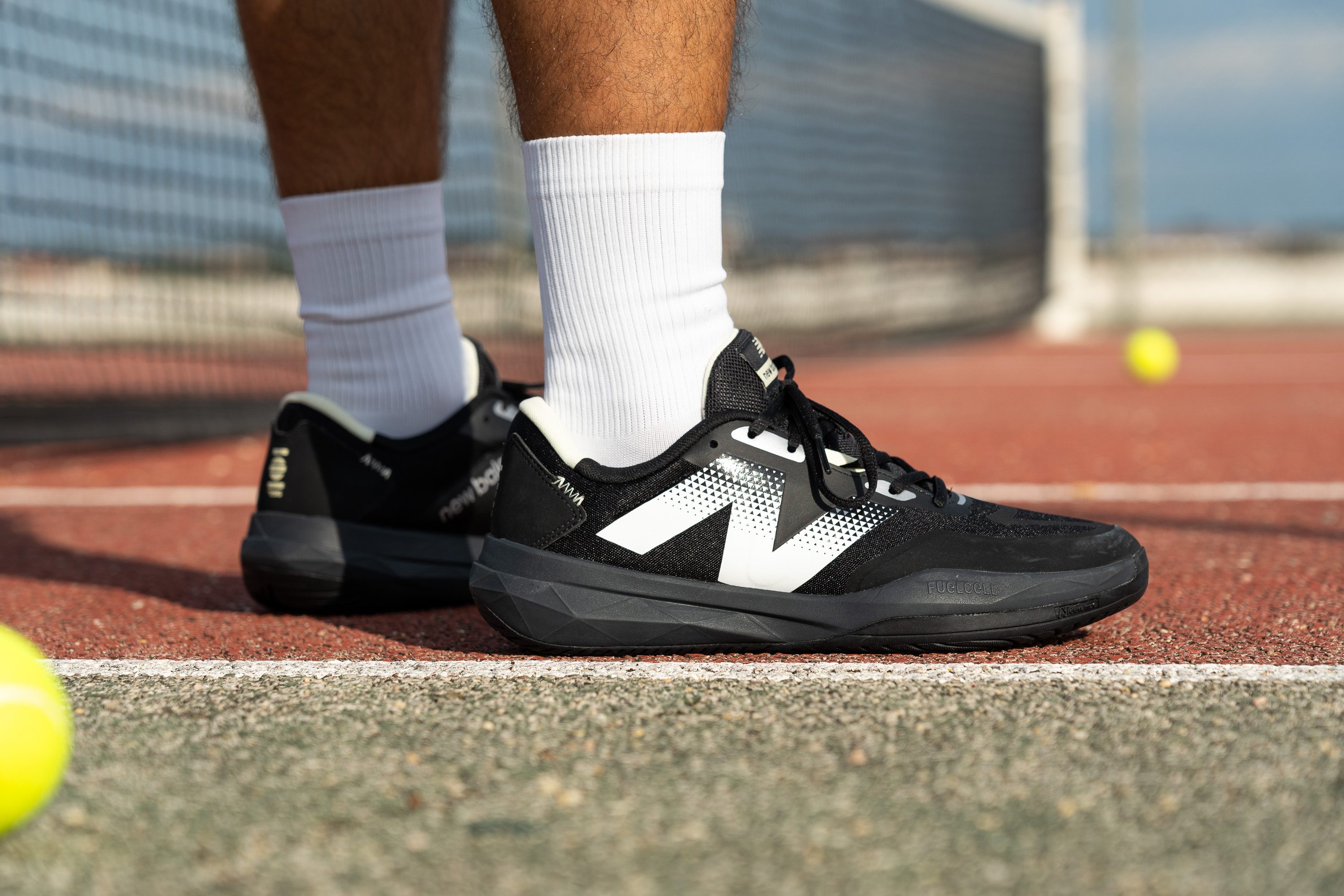
Who should NOT buy
Even as a budget-friendly shoe, the New Balance 796 v4 has some pretty tough competition in its price range. Thus, we highly recommend considering a few more alternatives before going for this NB shoe.
Here are some of them:
- ASICS Gel Dedicate 8 offers better breathability and is an ounce lighter
- NikeCourt Vapor Lite 2 has better breathability, weighs less, and is impressively more durable
- ASICS Gel Challenger 14 is a bit more expensive but offers next-level stability and durability
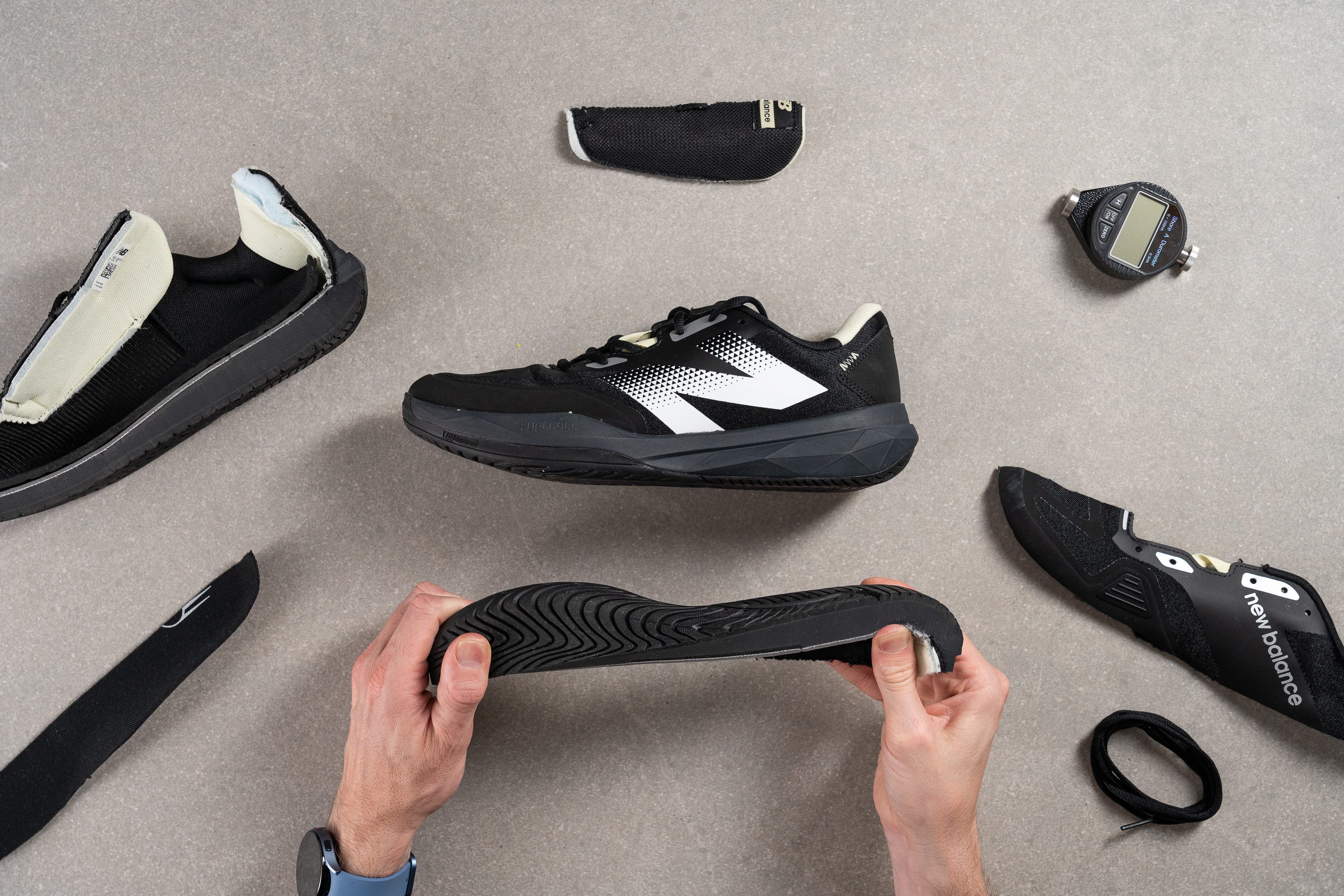
Cushioning
Heel stack
We are very glad that New Balance added more cushioning to the 4th iteration of the 796 because its predecessor certainly lacked in that department.
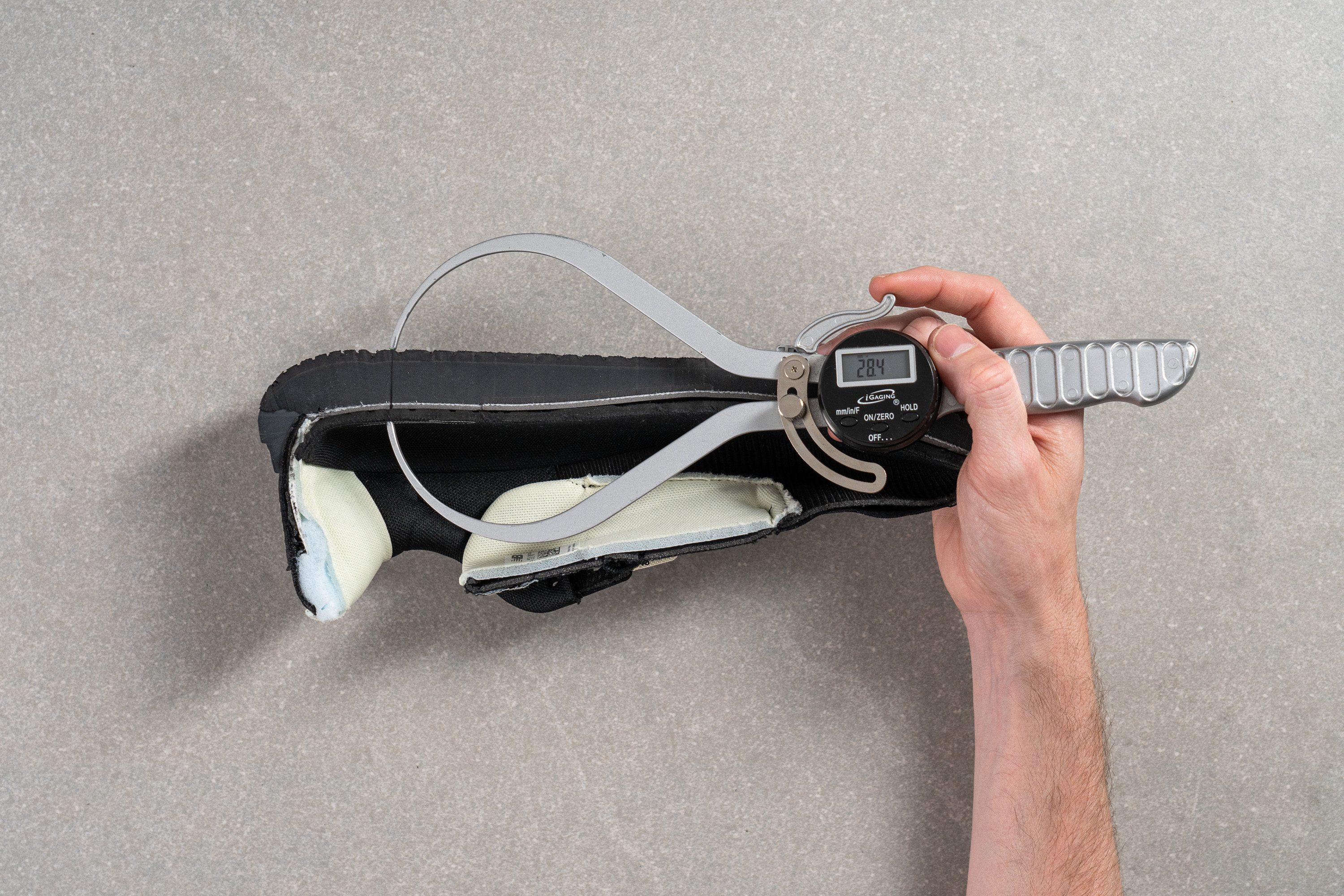
Seeing 28.4 mm on the caliper, we can confirm that the 796 v4 has just as much cushioning as the average tennis shoe. And it offers a sufficient amount of impact protection too.
| 796 v4 | 28.4 mm |
| Average | 29.2 mm |
Forefoot stack
Measuring the shoe's forefoot stack returned a reading of 20.9 mm which is also on par with the average.
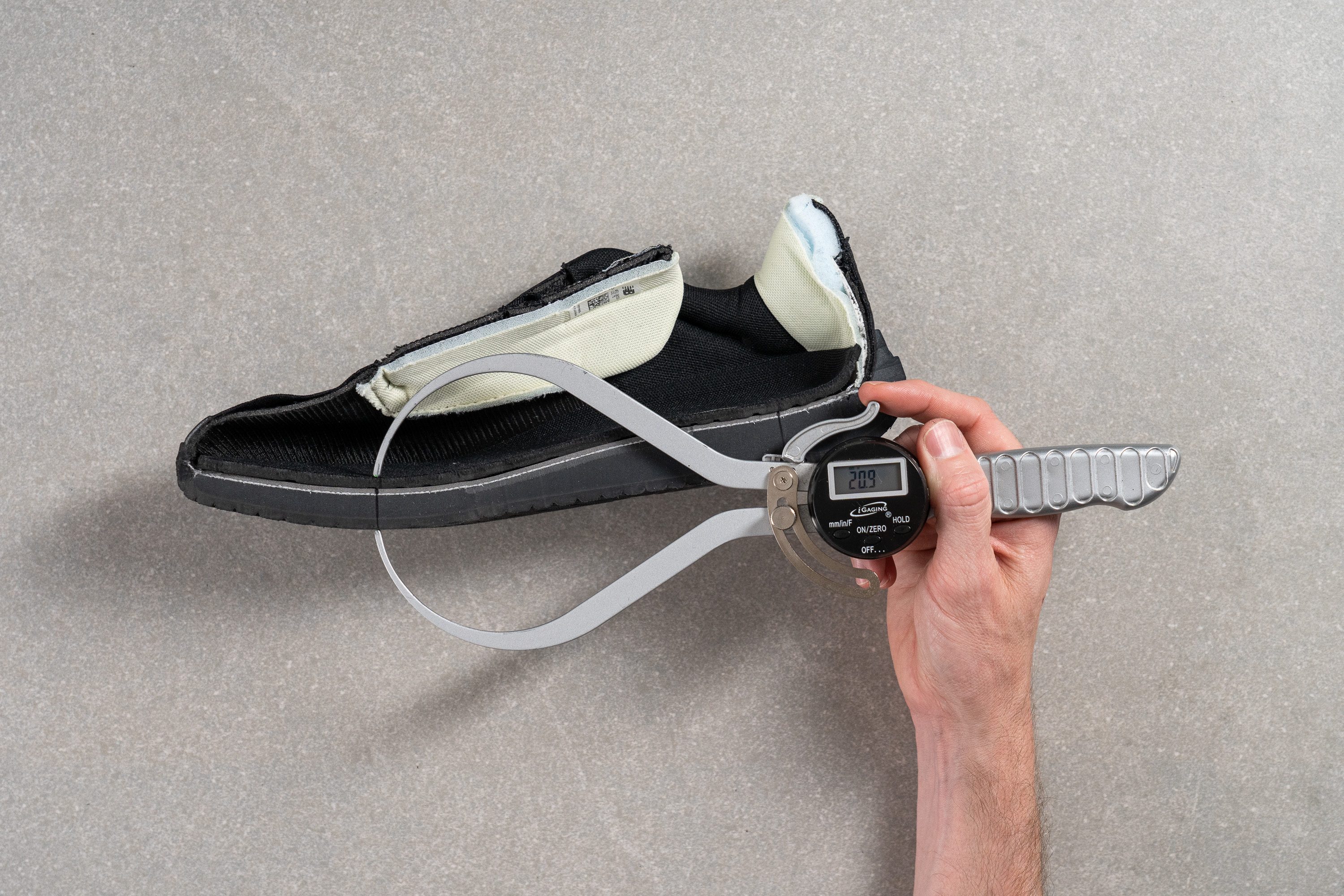
Having this much cushioning for the balls of our feet helped us stay on our toes throughout the whole session.
| 796 v4 | 20.9 mm |
| Average | 19.5 mm |
Drop
Based on our caliper measurements, the difference in stack heights in this NB shoe is 7.5 mm. This is not too far from what is stated by the brand (8.0 mm).
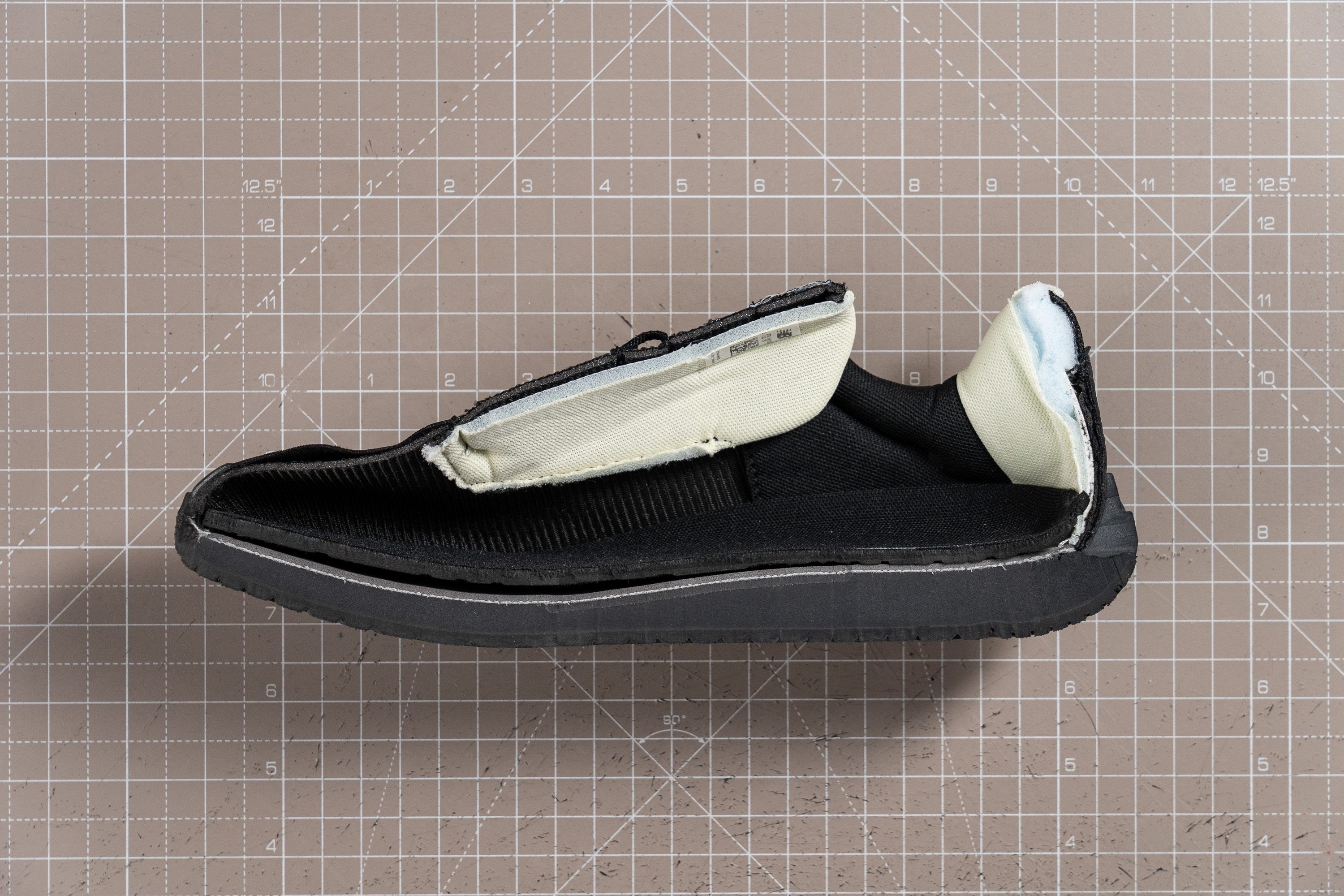
It is a very balanced offset which, in our opinion, is going to feel at home for the majority of players.
| 796 v4 | 7.5 mm |
| Average | 9.7 mm |
Midsole softness
We are pleasantly surprised with the brand's choice to replace REVlite foam with FuelCell for the 4th version of the 796. The latter treated us to a notably softer and livelier ride as we dashed to the net and back.
Pressing a Shore A durometer against the shoe's cut-up midsole, we got a reading of 25.5 HA. This is 18% softer than the REVlite foam of the v3 and is 12% softer than the average tennis shoe midsole.

| 796 v4 | 25.5 HA |
| Average | 28.1 HA |
Size and fit
Size
New Balance 796 v4 fits half size small (28 votes).
Consider sizing up
Width / Fit
Our feet were happy with the space provided by the New Balance 796 v4 in a D medium width. And it looks like the gel mold of the shoe's interiors confirms its true-to-size fit.
Measuring the mold's widest part with a caliper, we got a standard reading of 92.5 mm. This is on par with the average of tennis shoes we tested in the same size and width.
But if you need even more room, this NB shoe is generously offered in wide and extra wide versions too.
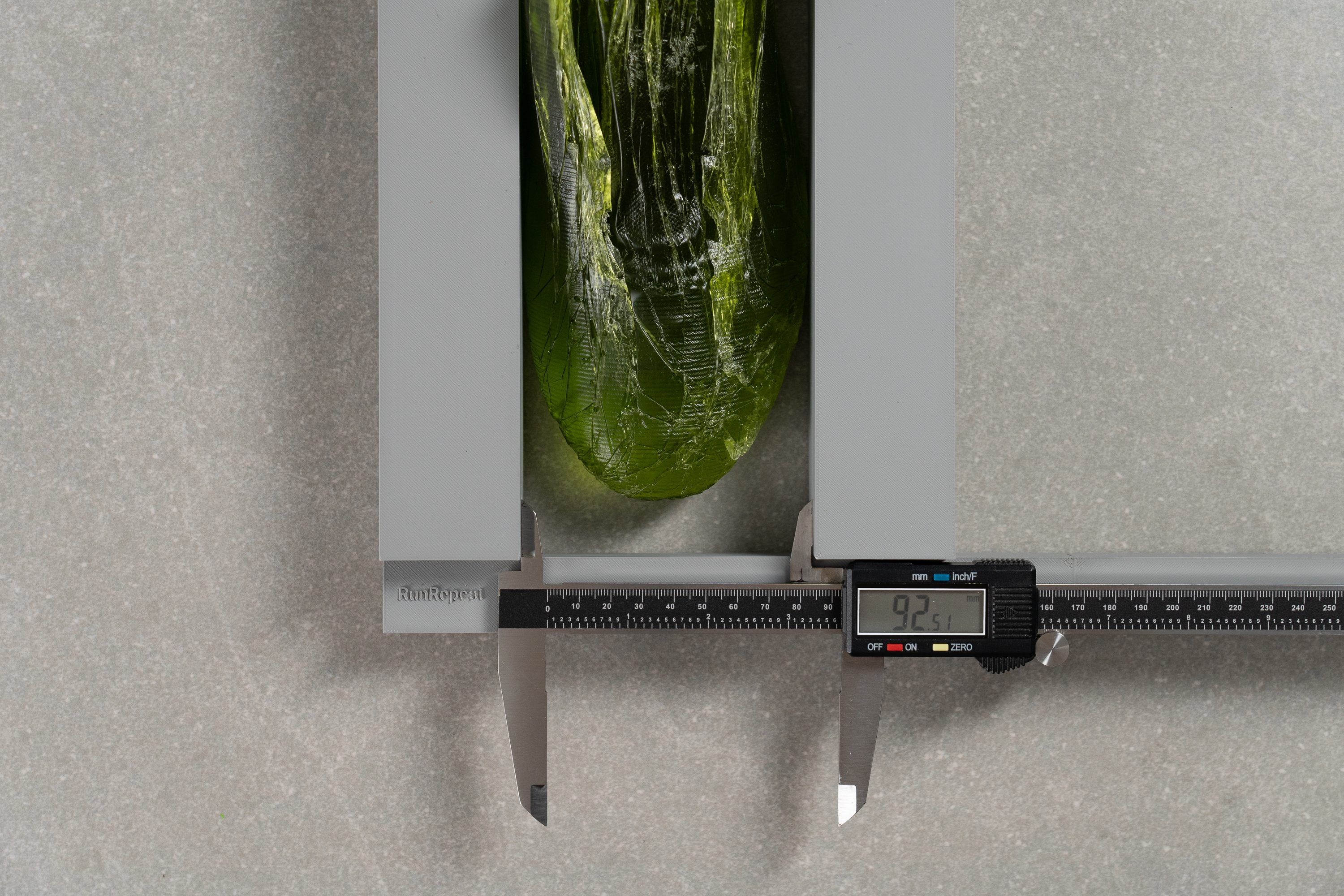
| 796 v4 | 92.5 mm |
| Average | 92.9 mm |
Toebox width
The rounded toebox shape also contributes to the in-shoe space of this New Balance shoe. Our caliper showed an above-average reading of 70.7 mm in the big toe area of the shoe's toebox.

| 796 v4 | 70.7 mm |
| Average | 69.2 mm |
Toebox height
On the downside, the shoe's toebox height turned out to be a bit shallower than average.
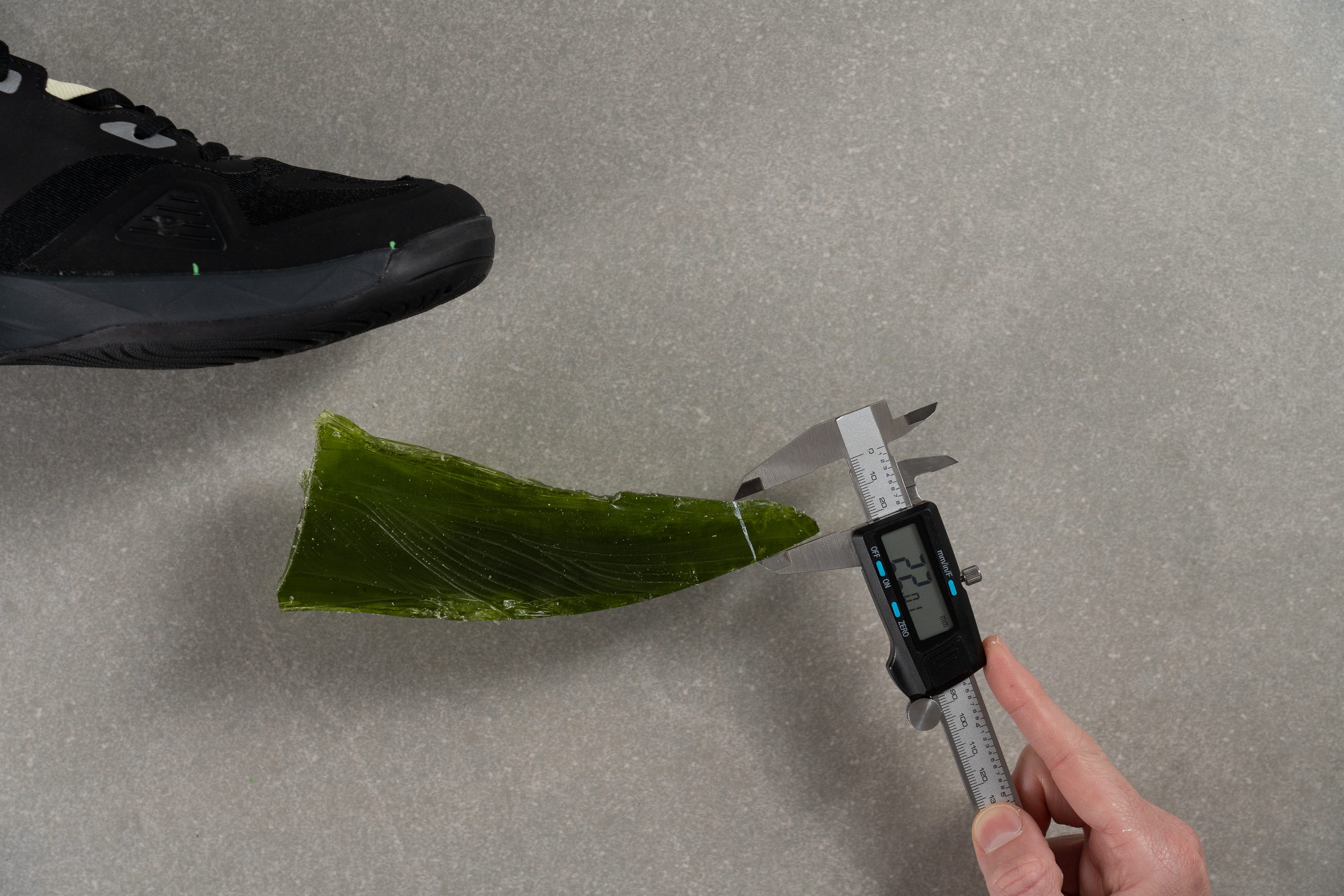
With a caliper measurement of 22.0 mm, it is pretty low to the toes.
| 796 v4 | 22.0 mm |
| Average | 25.1 mm |
Flexibility / Stiffness
Playtesting the 796 v4, we could feel its resistance to bending even though there was no shank inside the midsole! Such stiffness added a touch of snap and stability to the ride of this NB shoe.
When we measured the force it takes to bend it, our gauge indeed showed an above-average reading of 37.5N. That is 20% stiffer than the average tennis shoe.
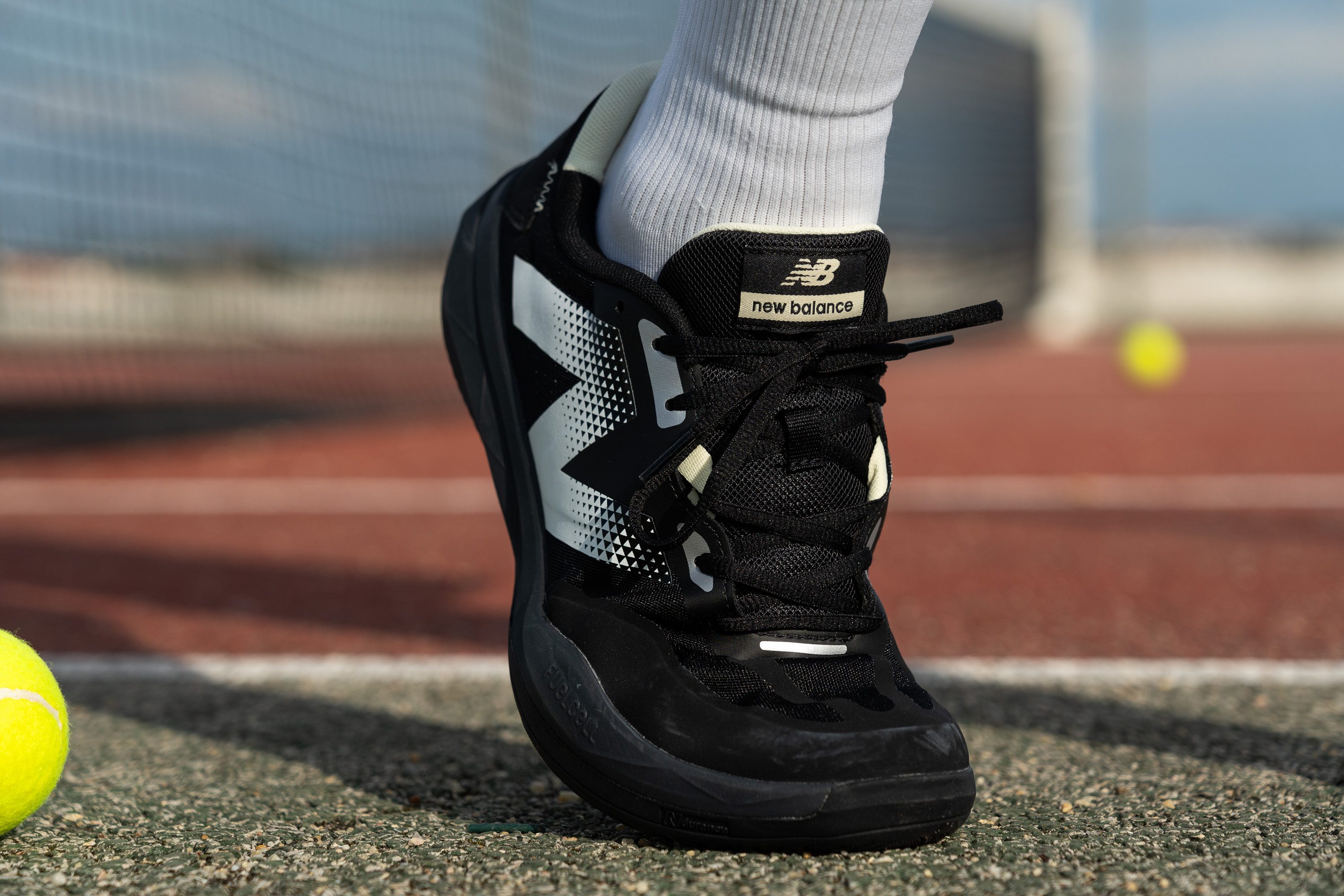
This test follows an older methodology, which is why you don't see recently tested shoes in the chart. Results from different methodologies can not be compared.
| 796 v4 | 37.5N |
| Average | 30.7N |
Weight
As a budget-friendly shoe that doesn't carry a ton of features, the New Balance 796 v4 doesn't weigh so much either.

Our scale recorded 12.2 oz (346g) in a men's US size 9 which is slightly lighter than a typical tennis shoe.
| 796 v4 | 12.2 oz (346g) |
| Average | 12.8 oz (362g) |
Breathability
Is this a tennis shoe for winter?
Because we have no idea what else could explain the total absence of breathability in the 796 v4!
Not even a tiny streak of smoke passed through the shoe's toebox in our smoke-pumping test!
We saw no hints of ventilation pores or perforations in the upper transparency test either.

What's more, a closer look at the fabric through our microscope revealed the most tightly woven material we've ever seen on a tennis shoe.
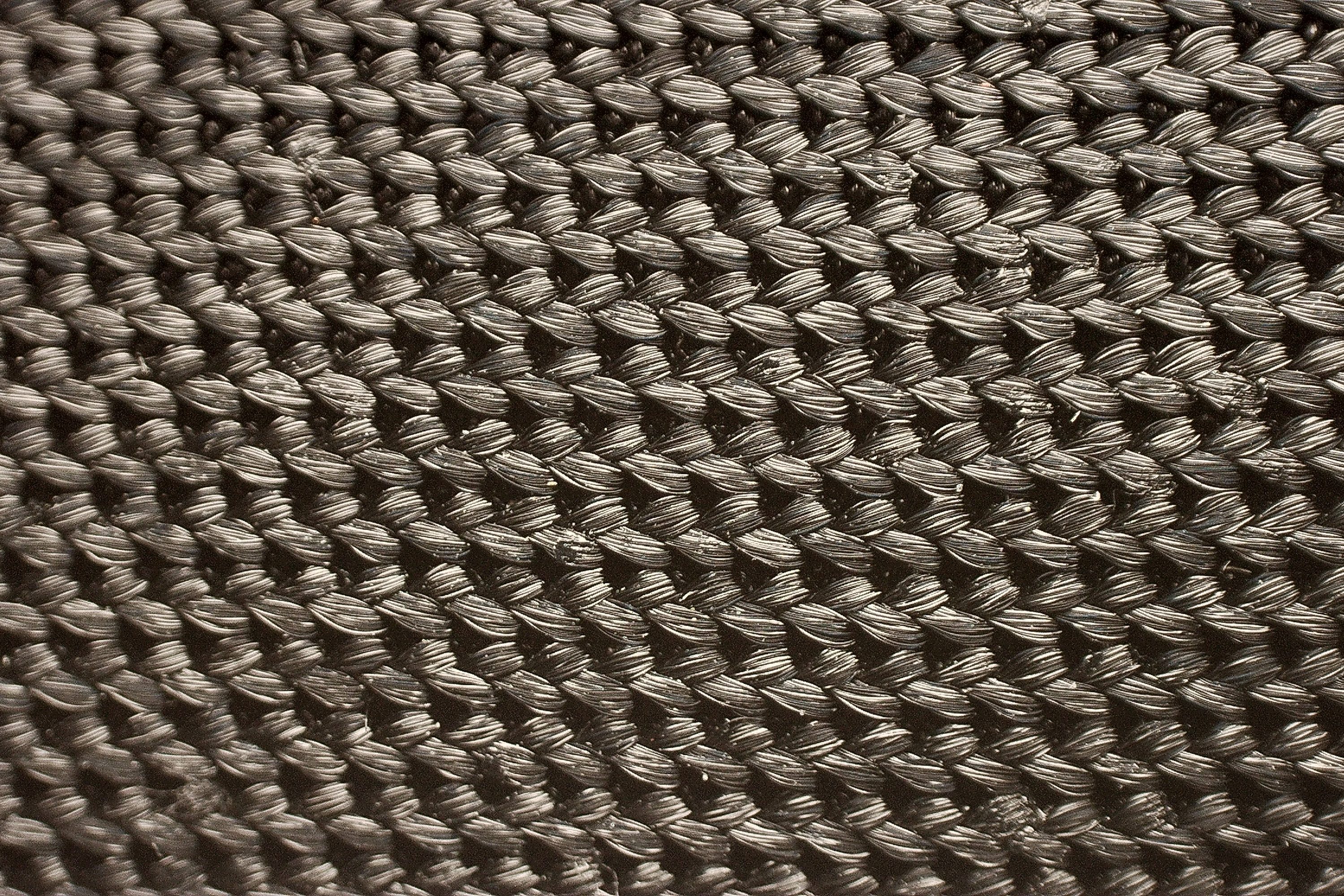
Maybe this New Balance shoe could work for chilly weather but it is otherwise a pretty suffocating experience. Thus, we gave it the lowest breathability score - 1 out of 5.
| 796 v4 | 1 |
| Average | 3.2 |
Stability
Lateral stability test
We didn't expect a lot of support from a shoe under $100 but the New Balance 796 v4 surprised us in a good way.
Quick cuts and crossover steps felt nice and stable in this NB shoe and its steady base also gave our feet and ankles sufficient push-off power.
But even though we felt a step up in stability over the v3, we can still think of even more stable shoes in the same price range. The TPU Wingwall of the ASICS Gel Challenger 14, for example, offers a lot more side support than the raised foam walls of the 796 v4.
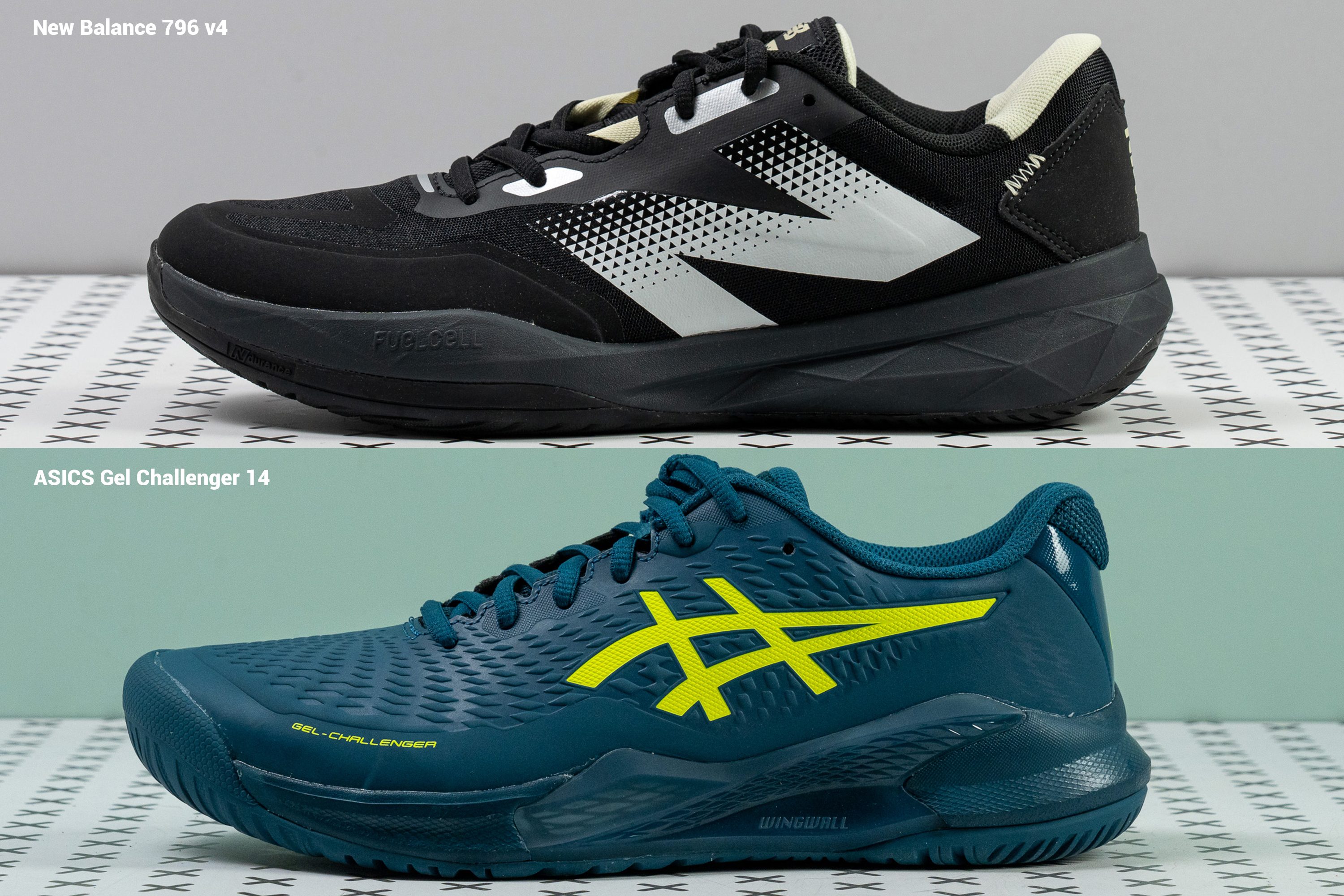
Torsional rigidity
And yet we should give those foam walls some credit for generating enough stability in the 796 v4.
The shoe was almost unyielding in our manual test. And because of how hard it was to twist, we rated its torsional rigidity with a high score of 4 out of 5.
| 796 v4 | 4 |
| Average | 4.4 |
Heel counter stiffness
We should also mention the shoe's very sturdy heel counter as it did a great job locking our heels and ankles down in place.
You can see from our manual check how resistant the whole rearfoot is to squeezing and pushing. We readily gave it the highest stiffness score of 5.
| 796 v4 | 5 |
| Average | 4.1 |
Midsole width - forefoot
Last but not least - platform width. It contributed to the overall stability of the NB 796 v4 quite significantly.
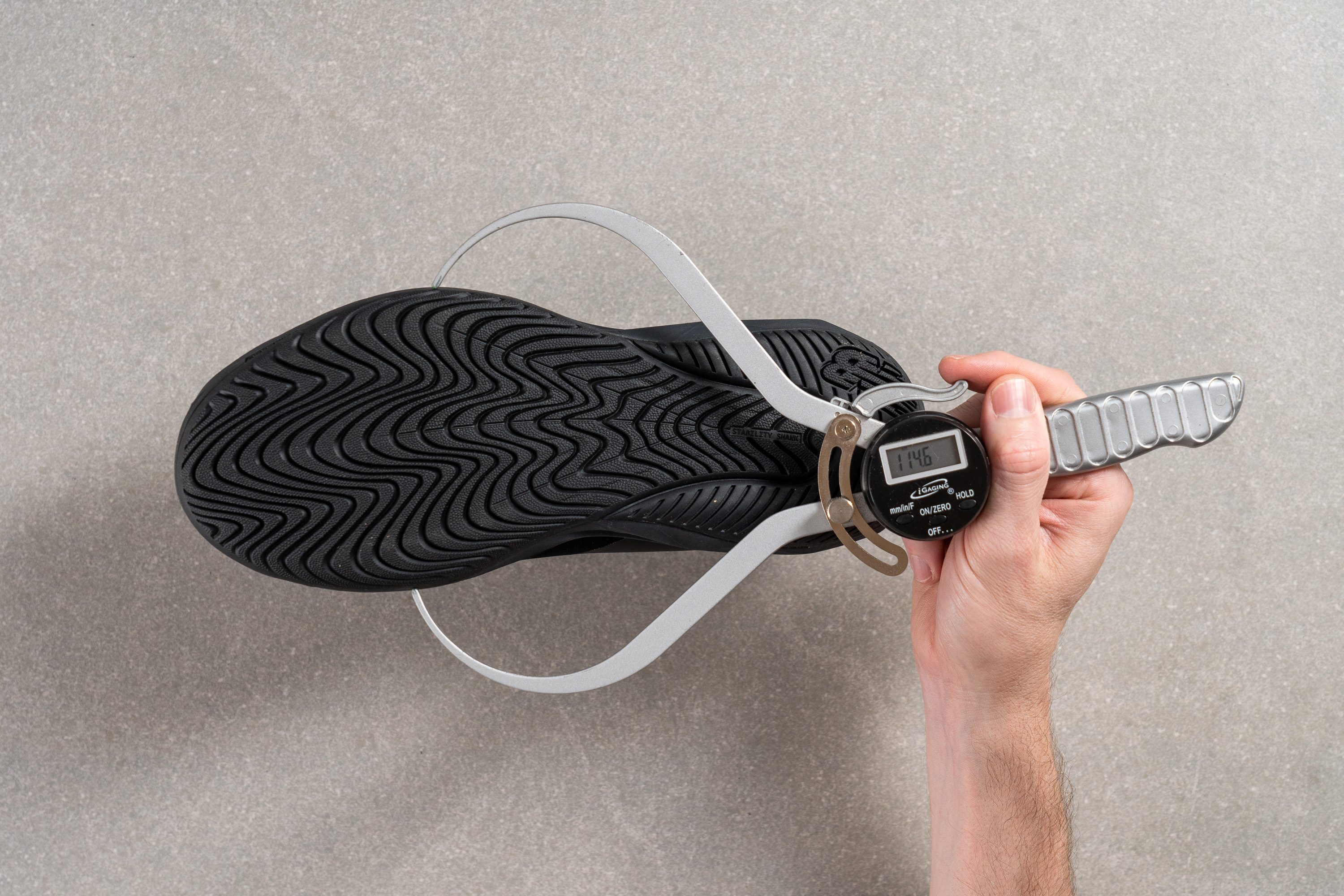
The midsole flares out on the lateral side showing 114.6 mm in the widest area. It is even a few millimeters wider than average.
| 796 v4 | 114.6 mm |
| Average | 111.9 mm |
Midsole width - heel
Checking the widest part of the shoe's heel, we were amazed to see almost 10 mm more compared to v3!
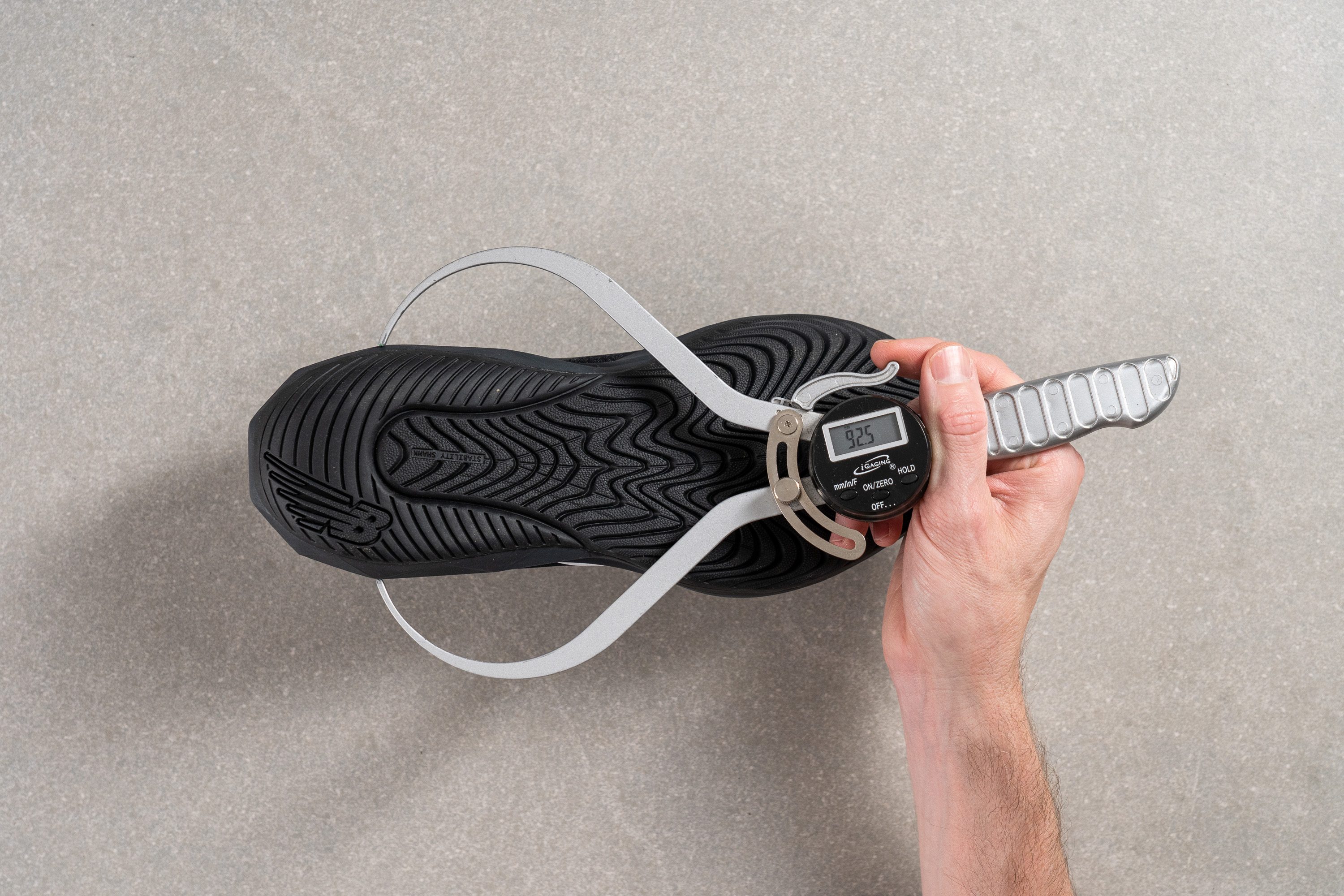
Now the widest part of the heel clocks in at 92.5 mm offering a broad and reliable base to lean on.
| 796 v4 | 92.5 mm |
| Average | 89.6 mm |
Durability
Toe guard durability
Most tennis shoes use large overlays made of rubber or TPU to protect the inner side of the forefoot from toe dragging.
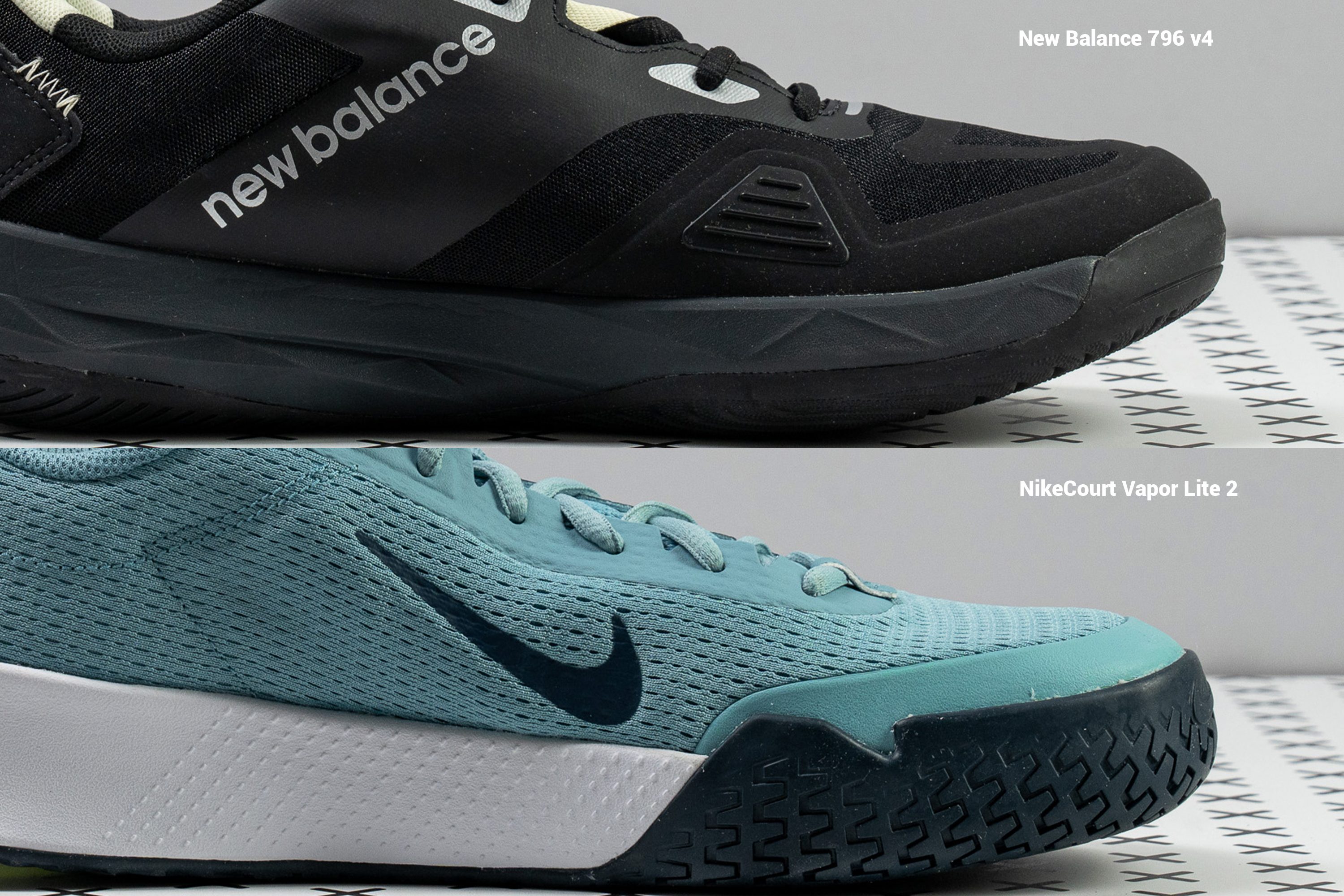
However, the NB 796 v4 chose a more targeted approach by placing a rubber patch in the most high-wear area.
That piece resisted our sandpaper test rather well. Even though we applied the Dremel at 10K RPM speed for 22 seconds, it didn't burn through the entire patch. For that, we give the shoe's toe guard durability a high score of 4.
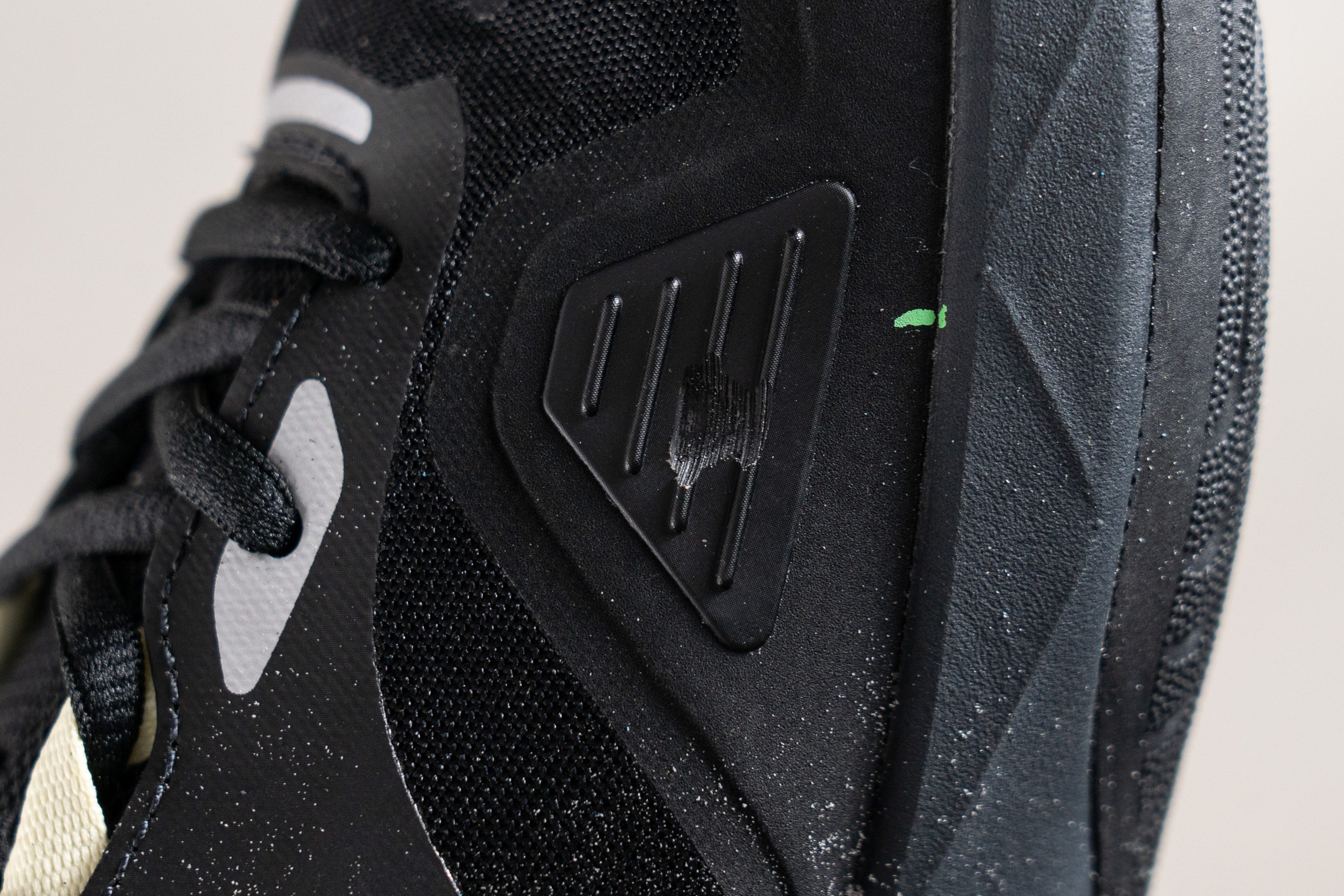
But we are still in doubt that the exposed mesh and foam around this patch can stand up to aggressive sliding.
| 796 v4 | 4 |
| Average | 3.3 |
Toebox durability
Our next test shows that the shoe's mesh won't survive regular brushes against outdoor courts.
Our Dremel dug into the fabric quite easily, cutting almost all the way through. But because the material showed some resistance, we bumped up the toebox durability score to 3 out of 5.
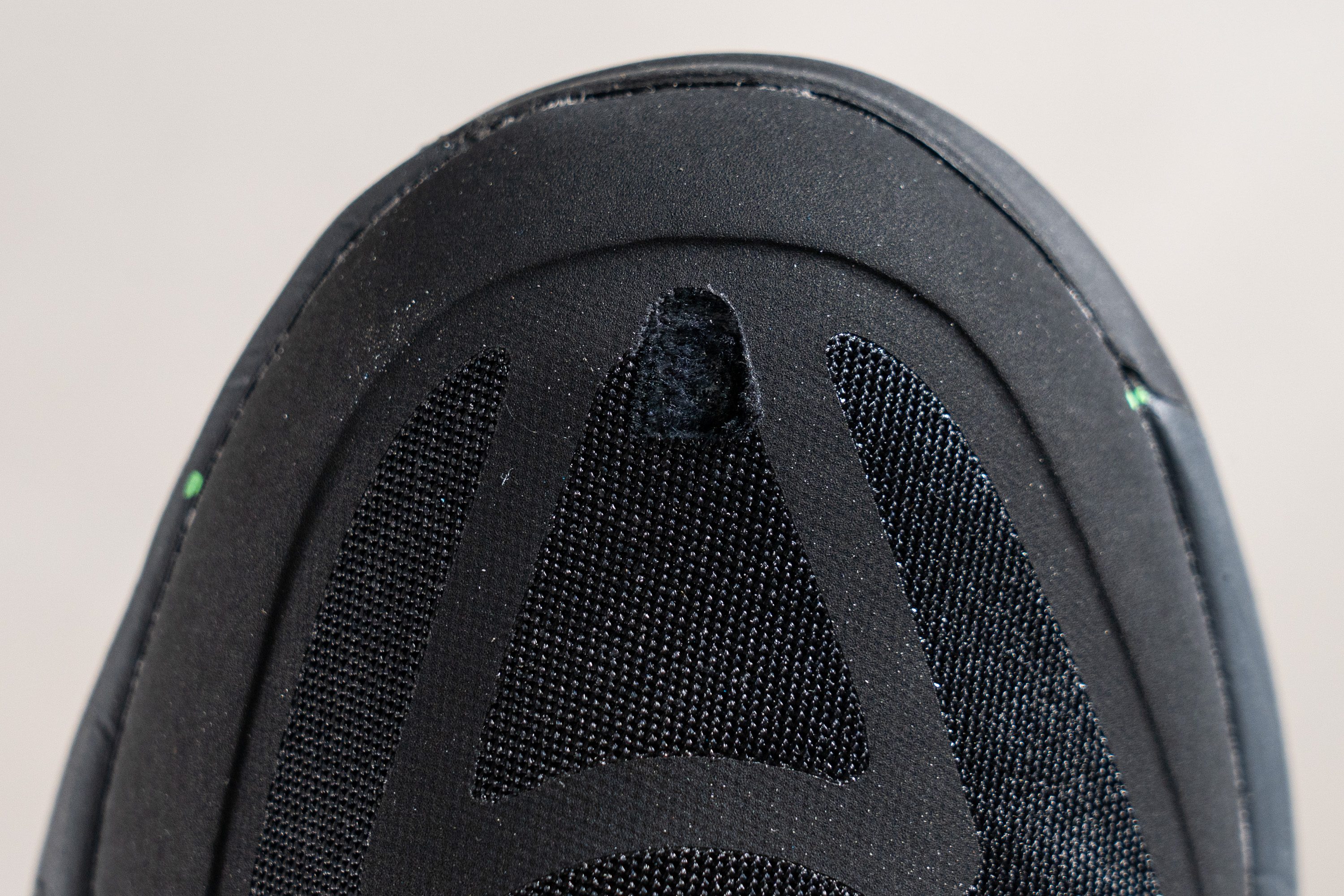
| 796 v4 | 3 |
| Average | 3.7 |
Heel padding durability
The inner lining, on the other hand, is a very frail one. Only 4 seconds of exposure to sandpaper destroyed the shoe's interior mesh completely.
Thus, we couldn't rate the heel padding durability of this NB shoe any higher than 1 out of 5.

| 796 v4 | 1 |
| Average | 3.3 |
Outsole hardness
Disclaimer: In this review, we are testing the Padel version of the NB 796 v4.
According to specs, the New Balance 796 v4 uses NDurance rubber for the outsole. But the more NB shoes we test, the more we find that this compound can vary from one model to another. Especially when you are comparing a $90 shoe (NB 796) and a $135 shoe (NB 996).

In the case of 796 v4, the hardness measurement showed a fairly standard durometer reading of 84.0 HC. However, its wear resistance doesn't seem to live up to the average...
| 796 v4 | 84.0 HC |
| Average | 86.0 HC |
Outsole durability
Drilling the shoe's rubber outsole for 22 seconds at 10K RPM speed, our Dremel burned a 1.2-mm deep dent.
This is deeper than what we normally see in tennis shoes. But let's not forget that the 796 v4 is also cheaper than the average.
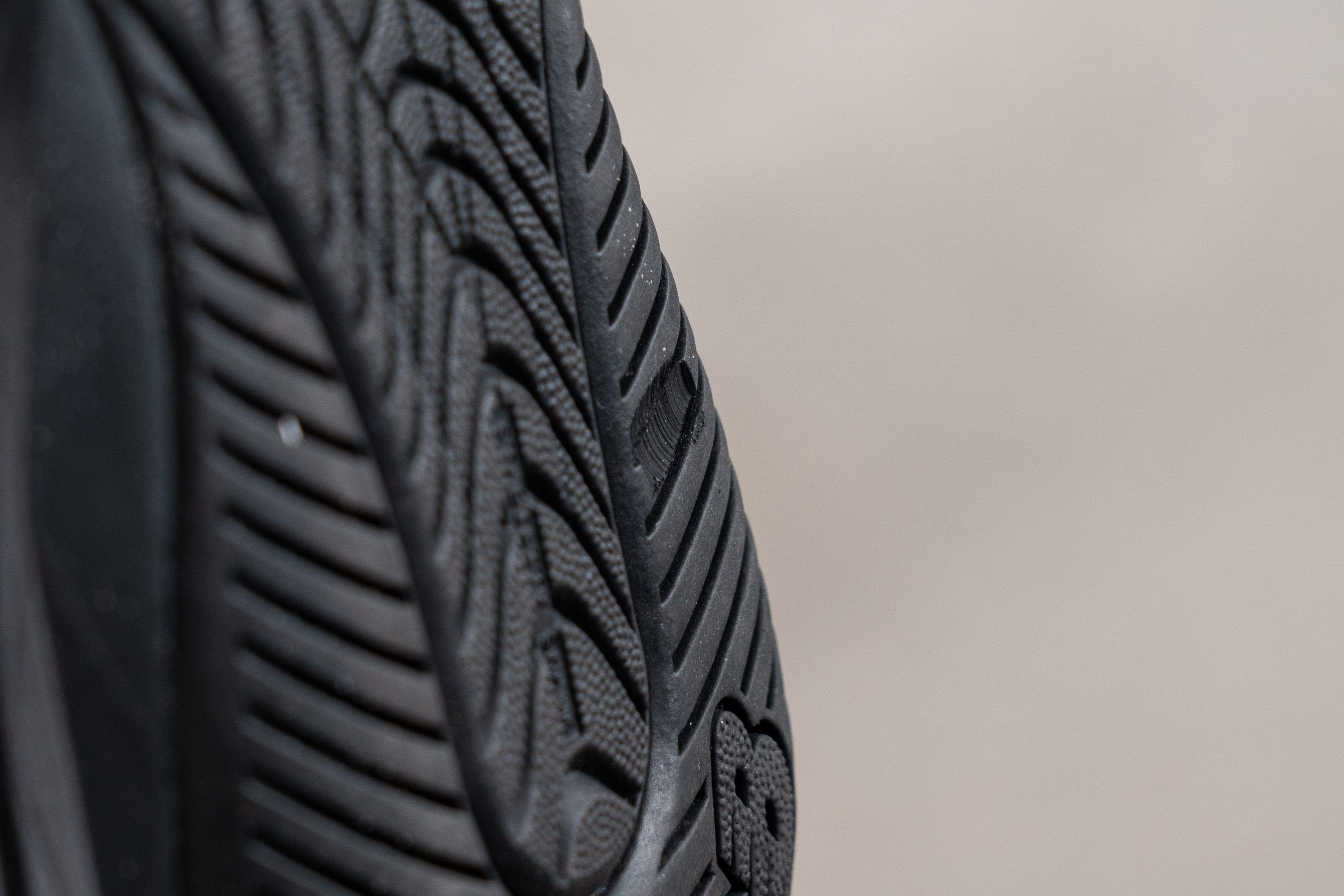
| 796 v4 | 1.2 mm |
| Average | 0.8 mm |
Outsole thickness
The fact that the NB 796 v4 packs an extra millimeter of rubber in the outsole (5.1 mm) gives us hope for its decent durability.

| 796 v4 | 5.1 mm |
| Average | 4.2 mm |
Misc
Insole thickness
The cushioning is topped off with a padded insole. Our caliper shows 4.7 mm of thickness in the heel which is standard for a tennis shoe insole.

| 796 v4 | 4.7 mm |
| Average | 5.1 mm |
Removable insole
The shoe's insole is easily removable.
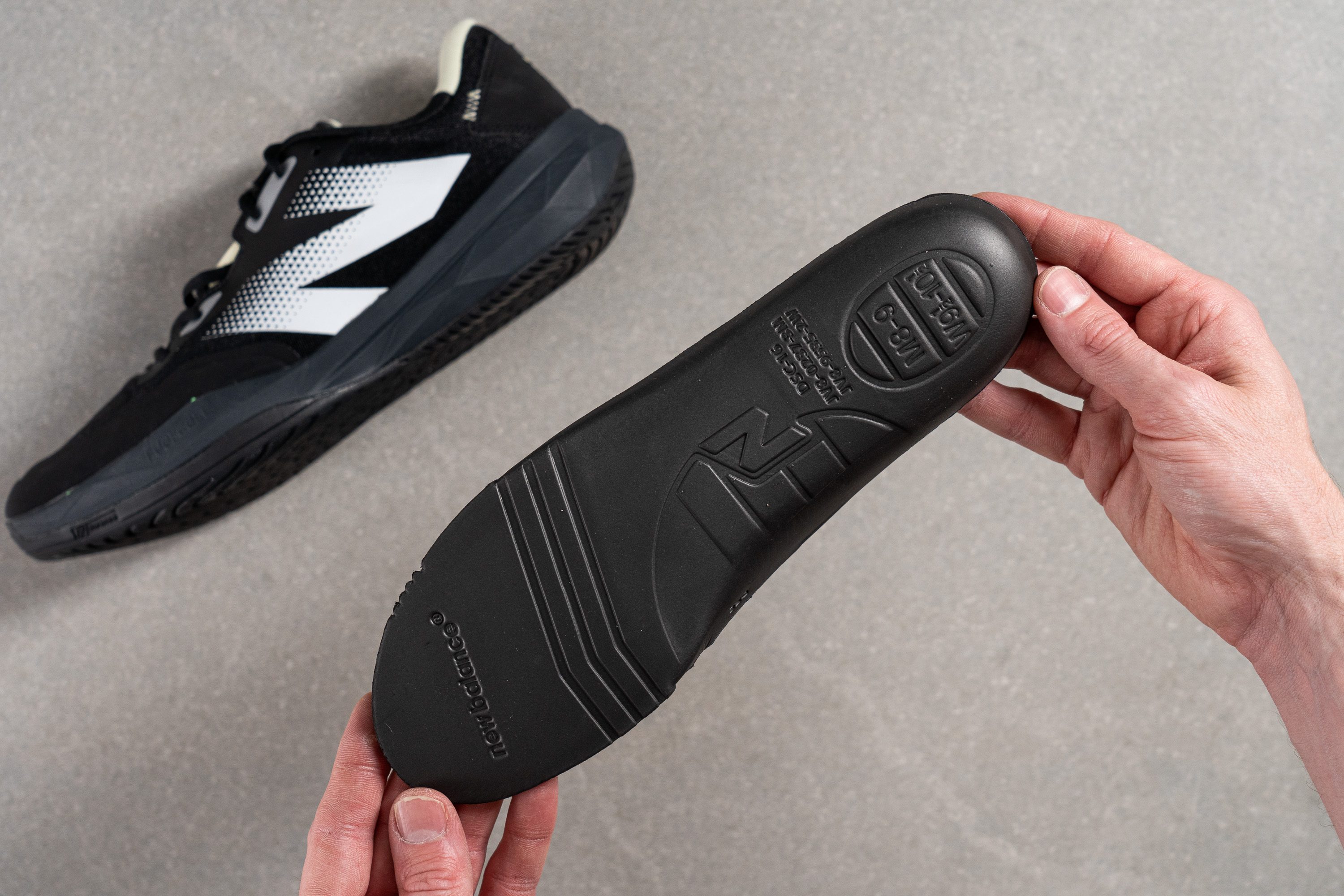
| 796 v4 | Yes |
Tongue padding
The tongue and collar of this New Balance shoe are nicely padded. We recorded 7.0 mm of padding in the tongue which is a common amount of foam for tennis shoes.
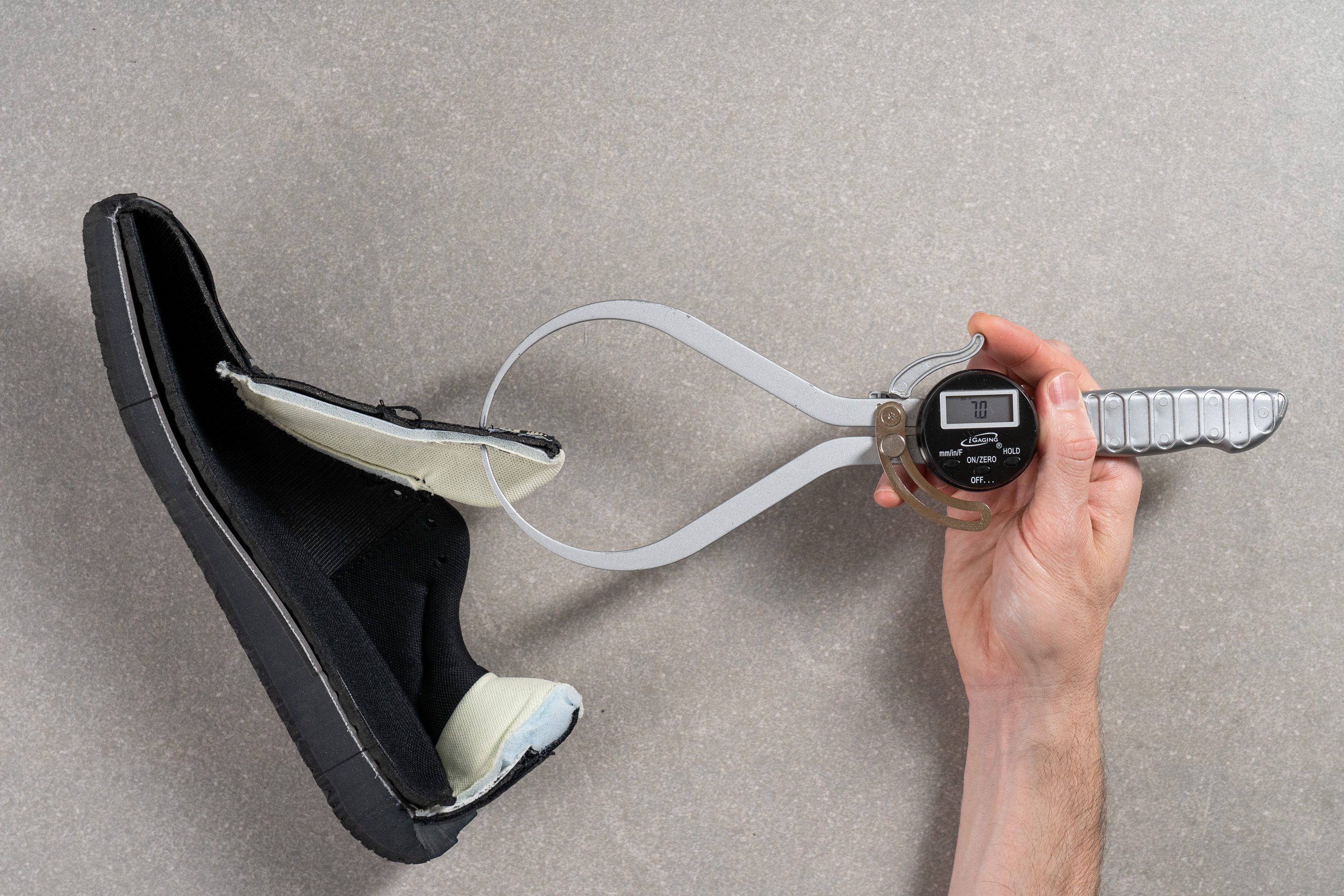
The padding gets even more generous in the collar of the shoe.
| 796 v4 | 7.0 mm |
| Average | 8.1 mm |
Tongue: gusset type
More affordable tennis shoes rarely gussets on the tongue and the 796 v4 doesn't have one either.
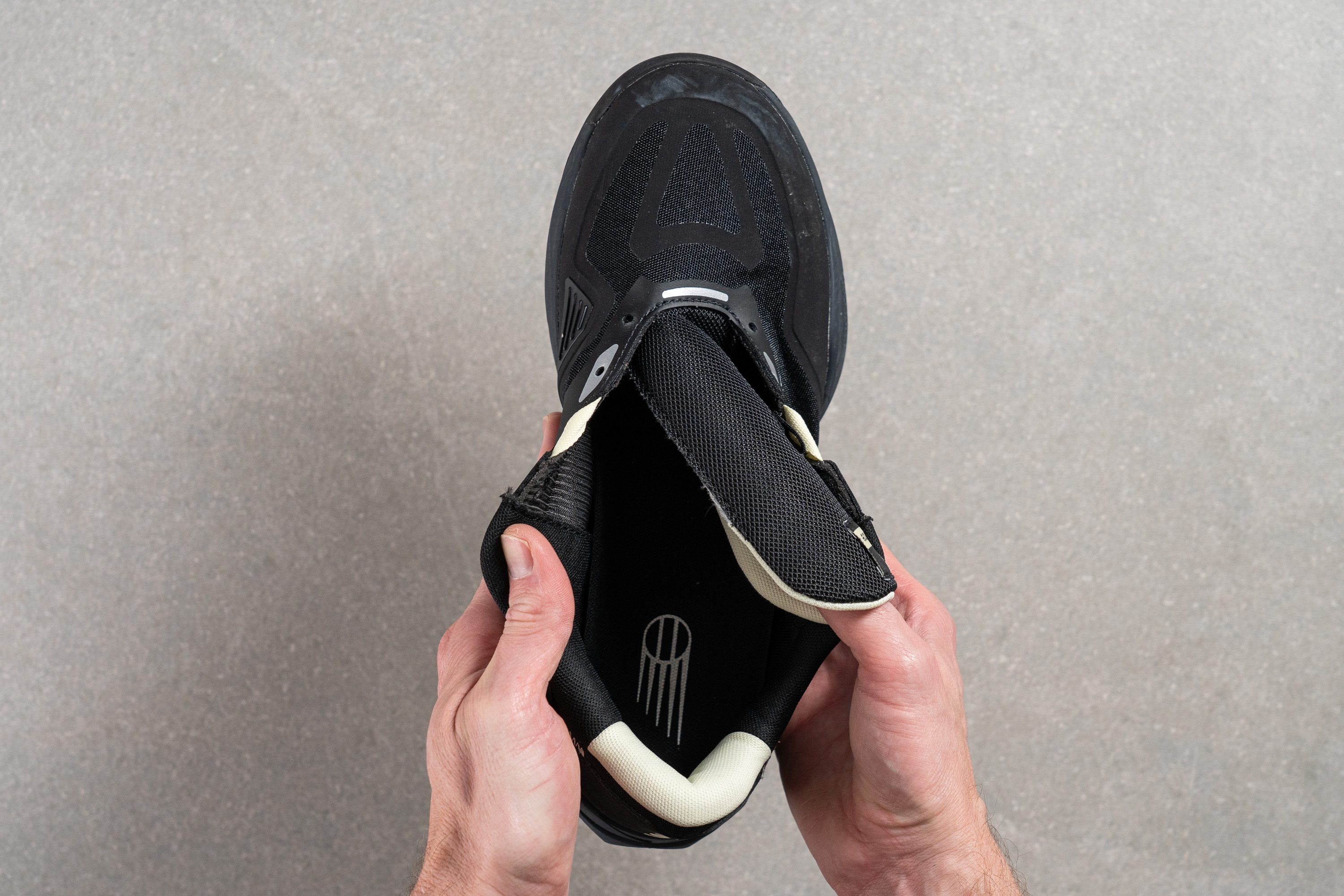
This resulted in some minor tongue shifting during side-to-side movements.
| 796 v4 | None |
Price
We believe that the below-average retail price of the New Balance 796 v4 is fair and the shoe offers great value for money. It is a solid entry-level option that's over 50% cheaper than the average tennis shoe.
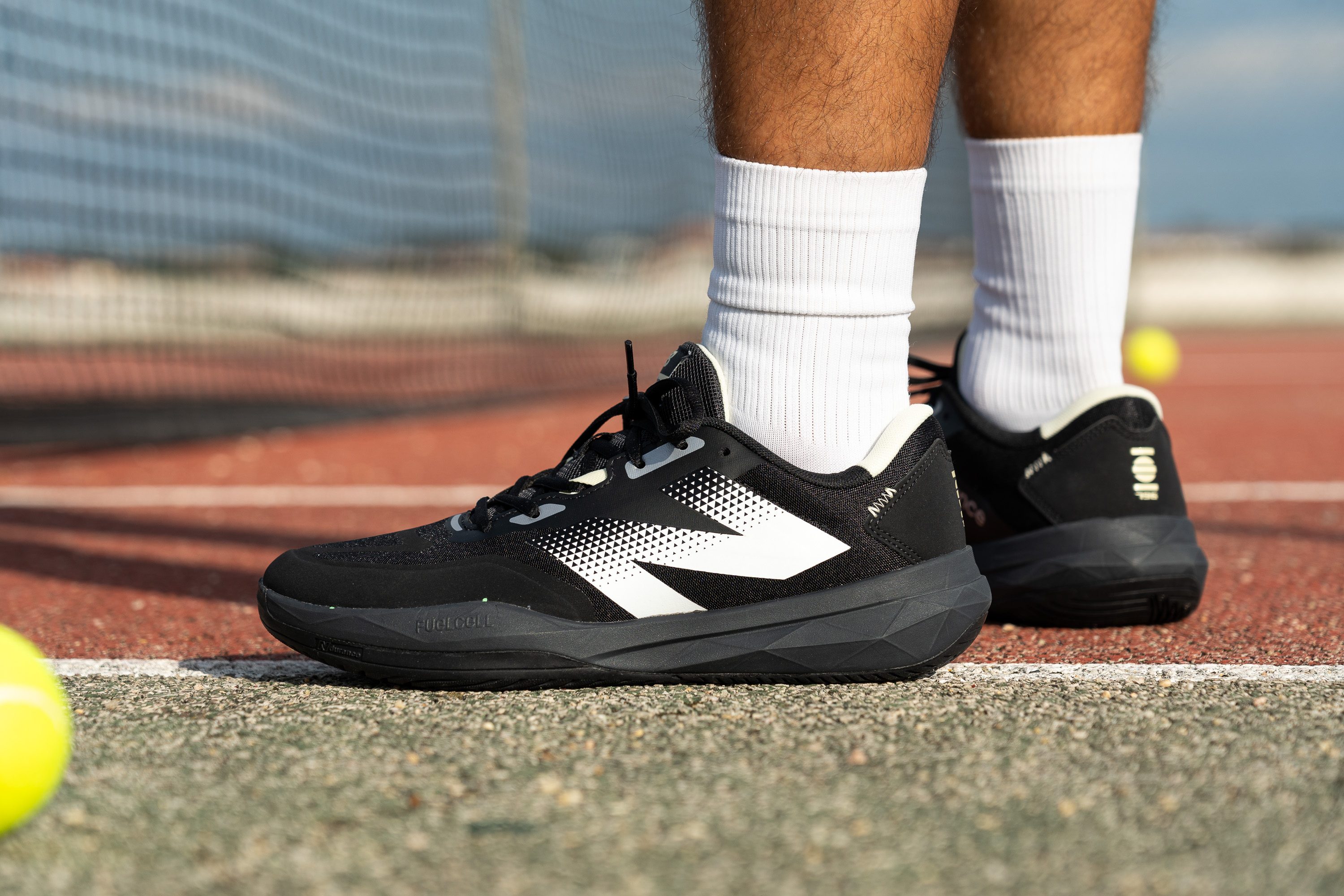
| 796 v4 | $90 |
| Average | $132 |
Heel tab
There are no heel tabs or finger loops but it is easy to get the 796 v4 on as it is.
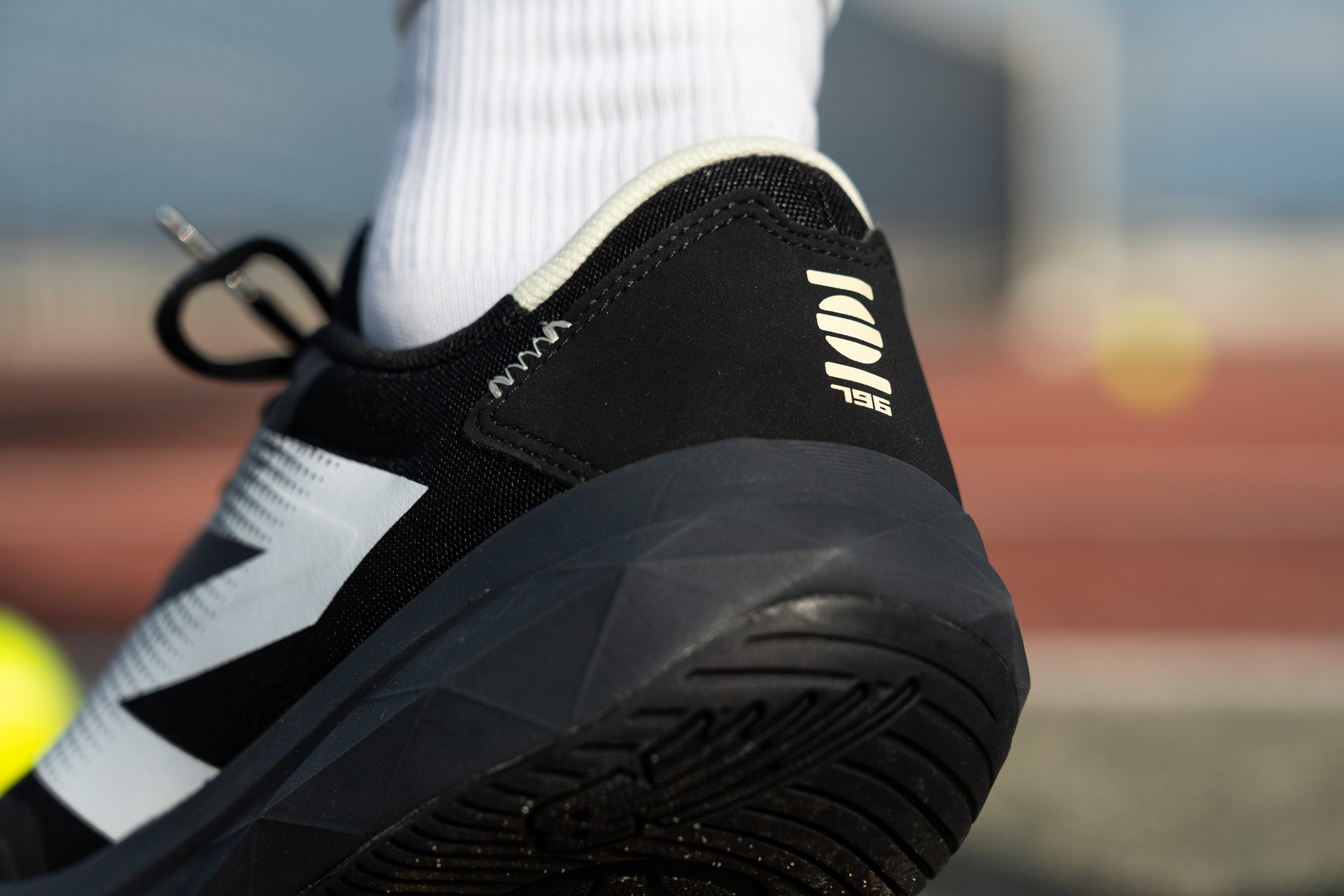
| 796 v4 | None |

